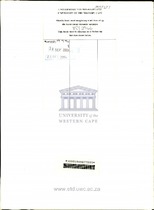| dc.contributor.advisor | Moola, M. H. | |
| dc.contributor.author | Kaka, Joolam | |
| dc.date.accessioned | 2021-08-23T15:26:42Z | |
| dc.date.available | 2021-08-23T15:26:42Z | |
| dc.date.issued | 1993 | |
| dc.identifier.uri | http://hdl.handle.net/11394/8388 | |
| dc.description | Magister Chirurgiae Dentium (MChD) | en_US |
| dc.description.abstract | state funded programmes are essential to provide a treatment for the dentally handicapped. To address this need a study was
undertaken under the auspices of the Orthodontic Department of the University of the Western Cape to assess the orthodontic needs of children in the Western Cape. The purpose of this study was to determine the occlusal traits of Indian children in the Western Cape and to compare them with samples internationally. The sample consisted of 355 children, 12-14 years old, from schools administered by the House of Delegates. They were examined and recorded according to the methods set out by Baume et al. (1973), and Angle's Classification (1899) with the Dewey- Anderson (1919 and 1960) and EI-Mangoury and Mustafa (1991) modifications The results of this study showed that bilateral molar relationships were: normal in 72.9%; mesial in 5.8% and distal in 15.5% of the children examined. The remaining had an asymmetrical molar relationship (5.8%). The upper incisal area was found to be the most crowded area in the mouth followed by the lower incisal area. Anterior crowding was present in 58.2% and spacing in 12.7% of the sample. The mean overjet was 2.7mm and the mean overbite 2 .1mm. In the posterior segments, open bites accounted for approximately 6.5% and crossbites for 8.3% On the basis of Angle's Classification it was found that 17.1% had a normal occlusion and 54.9% an Angles Class I malocclusion, 16.9% an Angle's Class II malocclusion and 5.5% an
Angle's Class III malocclusion. 5.6% of the candidates had an asymmetrical molar relationship. In comparison to other population groups the results suggest that the incidence of some occlusal traits of this Western Cape sample was similar to that of other population groups while some traits were more prevalent. The pattern of the distribution of Angles Classification was also similar to that reported in studies done elsewhere. | en_US |
| dc.language.iso | en | en_US |
| dc.publisher | University of the Western Cape | en_US |
| dc.subject | Orthodontic Department | en_US |
| dc.subject | Western Cape | en_US |
| dc.subject | Bilateral molar | en_US |
| dc.subject | Angles Classification | en_US |
| dc.subject | Malocclusion | en_US |
| dc.subject | Occlusion | en_US |
| dc.subject | Malocclusion | en_US |
| dc.title | The prevalence of occlusal traits in a selected Western Cape population | en_US |
| dc.rights.holder | University of the Western Cape | en_US |

